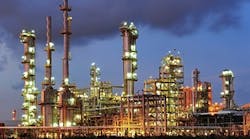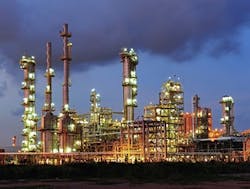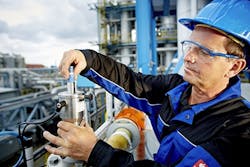The promise of the Industrial Internet of Things (IIotT) is so huge that vendors are realizing they must team up to offer customers a more comprehensive way to take advantage of digitalization. For instance, Rockwell Automation, AspenTech and Endress+Hauser exemplify how collaborations with data acquisition and analysis companies are easing chemical makers’ efforts to use the IIoT for asset optimization.
Technical advances and their successful uptake by other sectors are prompting a cultural change in the chemical industry, believes Gordon Bordelon, Greenville, S.C-based global chemical industry technical consultant with Rockwell Automation. “It’s a shift towards more agile plant performance and to getting more competitive with their existing plant assets. We are starting to see real gains in the industry,” he says.
Two other factors also are in play, he adds. First is the human capital issue. “Thirty percent of experienced operations staff are set to retire in the coming years. You need to capture their best practices and, at the same time, get the best data possible out of the plant so that you can empower the new generation of young operators hungry for data.”
The second is a big drive in the specialty/batch area to change products by tailoring molecules to specific customers and applications. “This requires a real agility and flexibility in the manufacturing process to adopt change, which in turn means better leveraging automation technologies,” he notes.
At the same time, there’s been a huge upsurge in the technologies available, with many different software companies offering innovative ways to gather and aggregate data, plus more advanced analytics techniques that all are enabling the rise of the IIoT.
Figure 1. Collaborations aim to assist in achieving asset optimization over the entire plant lifecycle. Source: AspenTech.
“However, as a company, we can’t have too varied a technology stack. So, we have to decide on which enabling technologies can be added for the benefit of our chemical industry customers. That has been the driver behind our different partnerships and strategic alliances,” he explains.
Bordelon points to the partnership with software specialist PTC, Needham, Mass., as being key in this respect.
“This partnership is all about enabling plant asset connectivity. A typical chemical plant today might have assets supplied and controlled by a dozen or more different vendors. The PTC portfolio can help with connectivity of disparate systems from multiple vendors and aggregate all this data and provide real-time insights. Operations today expect data on-demand, which is intuitive and can be securely served up on mobile devices anywhere in the enterprise. This is especially true for operators and maintenance personnel,” he stresses.
Rockwell also has a strategic alliance with Endress+Hauser (E+H), Reinach, Switzerland. With so much chemical industry data coming from instrumentation such as temperature, pressure, flow, level and other sensors and transmitters, the two have worked together to integrate E+H’s instrumentation portfolio with Rockwell’s automation architecture.
“What you get is a very straightforward application that ensures much better quality data that can be integrated and displayed through our HMI [human/machine interface] screen real-time and in an intuitive manner. This empowers operators and, for example, makes maintenance much quicker because the pertinent information is so easily accessed. This drives down mean time to repair (MTTR) and increases asset utilization.”
Rockwell Automation also leverages its PartnerNetwork programs to find and develop other enabling technologies.
For example, the company uses the PI historian from OSIsoft, San Leandro, Calif., to tie in its own visualization, analytics and reporting packages — giving users real-time insights into their processes. “PI is a fantastic tool for capturing, analyzing, visualizing and sharing large amounts of high-fidelity time-series data from multiple sources to people and systems across all operations — and there was no point in us recreating the wheel,” says Bordelon.
Other alliances include Cisco, San Jose, Calif.; Microsoft, Redmond, Wash.; and Panduit, Tinley Park, Ill. With a huge and growing emphasis on cybersecurity, Rockwell is working with all three to develop standard reference architectures and tools for how to protect industrial networks. “Today, chemical customers are looking to adapt IT/OT [information technology/operational technology] convergence to access data through a secure and standard unmodified Ethernet. Cisco is heavily involved in this, too” he adds.
Panduit’s expertise in turnkey industrial data centers (IDCs) also is important to Rockwell. “These preconfigured, fully assembled and tested IDCs are a cost-effective solution for chemical producers to build their modern infrastructure with. They are experts in deploying high-speed networks, Ethernet and data centers that OT folks on chemical plant floors don’t have experience with,” he notes.
One PartnerNetwork strategy that Bordelon believes is unique is Rockwell’s use of solution partners (SPs) and solution integrators (SIs). “Often former workers from the local customer facility, they know the production facilities intimately and understand the processes and challenges involved. We find that this is a very powerful way to ensure that our technology is implemented.”
He expects the chemical industry unrelentingly to boost its reliance on data, as the cost of data collection and storage continues to fall. This, he feels, will lead to greater use of augmented reality and mobile devices to ensure that people understand in real time any issues they have with their processes. It also will drive improved standards of environmental performance and sustainability, cybersecurity and knowledge acquisition and transfer, he suggests.
Lifecycle Focus
Asset optimization across the entire design, operation and maintenance lifecycle of chemical plants is the driving force behind AspenTech’s diverse collaborations (Figure 1).
“While some take a reseller or implementation services provider approach, all of our agreements come about because our partners are interested in our best-of-breed asset optimization software,” says Robert Golightly, senior product marketing manager for AspenTech’s Asset Performance Management (APM) business unit, Houston. “Our goal is to make advanced analytics and machine learning software accessible to chemical companies by lowering cost and expertise barriers. Our asset optimization software is focused on real-world operational excellence use cases, prioritizing areas of impact and quantifying improvement targets — which are top priorities for chemical companies worldwide,” he explains.
Many recent partnerships focus on making the company’s APM software more broadly available. Included here are tie-ups with: Advantech B+B SmartWorx, Ottawa, Ill.; SAP, Walldorf, Germany; Microsoft (Azure cloud computing service); ProSensus, Burlington, Ont.; and PinnacleART, Pasadena, Texas.
Figure 2. Sharing cloud and field instrument expertise will give seamless access to tools and quality asset data. Source: Endress+Hauser.
The Advantech B+B SmartWorx agreement differs from others in that it relies on AspenTech’s deep understanding of the specific industrial and business environments of chemical companies, notes Golightly.
“These companies are looking to digitally transform, but they need compelling ROI [return on investment], and that’s what is being delivered in a comprehensive out-of-the-box, drop-in solution that can reduce deployment costs by up to 70% — in most cases, a solution can now be implemented in days instead of weeks,” he stresses. “The connectivity and manageability of this simplifies the IIoT applications chemical companies need today and seamlessly integrates and interoperates with legacy systems and performs in rugged, demanding plant conditions,” he adds.
Connected assets are critical to improve performance and manage risk. However, AspenTech estimates that up to 40% of plant assets remain stranded because of weak (if any) internet connections, old equipment lacking sensors, and multiple, incompatible protocols for data from assets on site from diverse vendors.
“It’s all about working with what chemical plants have on premises today to achieve ROI. Pushing analytics algorithms to sensors and network devices alleviates the processing strain on other systems within the network. Even as the number of connected devices and amount of data collected increase, so does the ability to both scale up and scale out,” notes Golightly.
So, for example, Aspen Edge Connect software on Advantech B+B SmartWorx edge devices implements buffering, data aggregation, data compression and analytics to optimize and overcome communication barriers with stranded assets that rely on cellular and satellite connectivity.
Chemical firms, notably leading specialty chemicals manufacturers, are seeing excellent benefits because the technology puts them on the path to digital transformation without costly, disruptive “rip and replace” of existing infrastructure, he says.
“They’re getting a low-cost, highly scalable IIoT infrastructure — a drop-in solution that recognizes the reality of stranded assets in chemical plants and solves the connectivity issue in a way that works from a cost, deployment and performance perspective.”
In another example, the link between Aspen Mtell prescriptive maintenance software and SAP PartnerEdge is all about giving companies quick, easy access to a software application with the ability to deliver early, accurate warning of equipment failures and unplanned downtime and prescribe detailed actions to mitigate or solve problems.
Here, Golightly cites feedback from Borealis, Vienna: “Aspen Mtell predictive maintenance software’s ease of implementation will allow us to develop data analytics, including pattern recognition and early anomaly detection, in all operating functions, leading to increased performance in safety, quality, reliability and overall improved performance in manufacturing. With significantly earlier warning of asset degradation, we will have the time to work collaboratively to mitigate the losses of unplanned downtime and to minimize disruptions to our customers.”
“The company gained longer lead time detection of repeating failures, including 27 days advance notice for a central valve failure,” adds Golightly.
In October, AspenTech and Emerson Automation Solutions, Round Rock, Texas, launched a new integration technology to make creating digital twins across an entire plant’s lifecycle easier for users.
The technology — the first fruit of the two companies’ February 2018 alliance — allows bulk data transfer between Emerson’s Mimic software for real-time simulation of plant behavior and AspenTech’s HYSYS software for process simulation. This reduces integration time and engineering hours. The technology lowers two of the most significant barriers to digital twin utilization: total cost of ownership and maintainability, says Emerson.
Field Instrument Integration
Meanwhile, in June, E+H announced a collaboration with SAP. The goal of the pact is to fully integrate E+H field instruments as digital twins into the SAP cloud platform — essentially to realize end-to-end OT/IT integration from field instruments all the way to business processes.
Many of today’s large-scale IIoT projects are developed from scratch, notes Rolf Birkhofer, managing director of E+H Process Solutions. “This involves selecting an IIoT platform software, then planning the field components and gateways and, as a last step, programming the application on the IIoT platform. Generally speaking, this is a tedious approach that requires entering uncharted territory at many different points, especially when it comes to the interfaces,” he says.
So rather than re-inventing the wheel every time, the two companies want to develop a standardized approach that will allow them to offer, develop, execute and maintain customer projects.
“The advantage for our customers is that right up-front, they will have reliable information regarding components and tested interfaces,” adds Birkhofer.
The SAP work also includes development of a standard interface between the SAP software and E+H’s own cloud, so users get seamless access to tools and quality asset data.
This combination will offer shared cloud and application expertise that will completely cover the chemical industry at the field level (Figure 2), he believes.
It also will help bring about two different types of innovations on the maintenance front, he expects.
One involves software applications to better help predict potential outages in a timely fashion. Coupled with the E+H’s existing apps that use real-time data to warn of, for example, out-of-calibration electrodes, this could allow maintenance staff to determine the best timeframe in the production cycle to carry out their work.
The other is by linking real-time information from the plant to existing metadata in the company’s IIoT portal. “Using algorithms which are fed from the vast amount of data we have in our repository we convert this information into useful insights,” stresses Birkhofer.
Besides its ongoing collaboration with Rockwell Automation, E+H is working with other vendors on an intrinsically safe physical layer for 2-wire Ethernet. It also plans to invite a number of software companies to join its IIoT ecosystem in an effort to generate additional value.
If you take a look at the opportunities that the Internet, cloud technologies and the globalization of knowledge offer from the standpoint of a sharing economy, it makes a lot of sense to focus on the utilization of various pools of know-how. I can well imagine that data analytics companies would be interested in analyzing the data that we acquire through the process automation assets in a neutralized, anonymous form and then identify patterns and optimization potential. What would have been nearly impossible ten years ago is suddenly within close reach,” he concludes.





